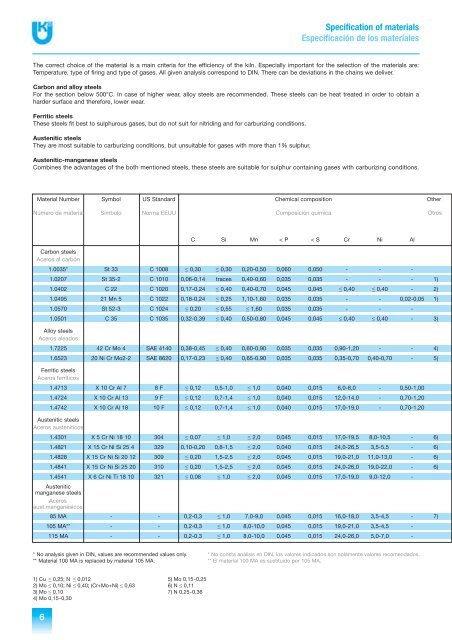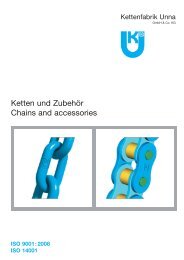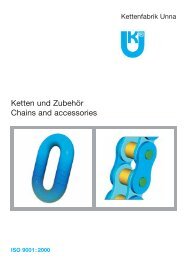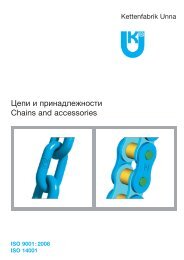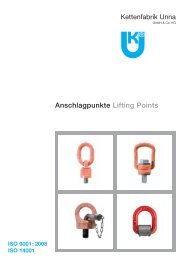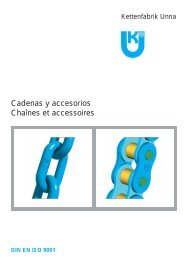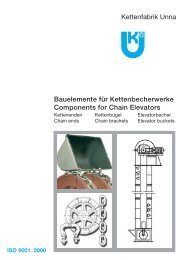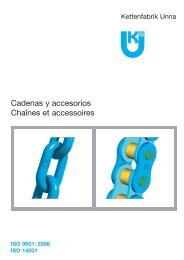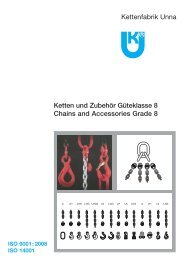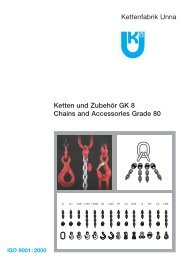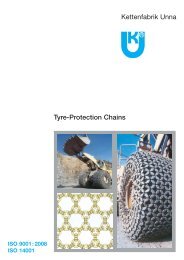Rotary Kiln Chains Cadenas para hornos rotativos Kettenfabrik Unna
Rotary Kiln Chains Cadenas para hornos rotativos Kettenfabrik Unna
Rotary Kiln Chains Cadenas para hornos rotativos Kettenfabrik Unna
You also want an ePaper? Increase the reach of your titles
YUMPU automatically turns print PDFs into web optimized ePapers that Google loves.
6<br />
Specification of materials<br />
Especificación de los materiales<br />
The correct choice of the material is a main criteria for the efficiency of the kiln. Especially important for the selection of the materials are:<br />
Temperature, type of firing and type of gases. All given analysis correspond to DIN. There can be deviations in the chains we deliver.<br />
Carbon and alloy steels<br />
For the section below 500°C. In case of higher wear, alloy steels are recommended. These steels can be heat treated in order to obtain a<br />
harder surface and therefore, lower wear.<br />
Ferritic steels<br />
These steels fit best to sulphurous gases, but do not suit for nitriding and for carburizing conditions.<br />
Austenitic steels<br />
They are most suitable to carburizing conditions, but unsuitable for gases with more than 1% sulphur.<br />
Austenitic-manganese steels<br />
Combines the advantages of the both mentioned steels, these steels are suitable for sulphur containing gases with carburizing conditions.<br />
Material Number Symbol US Standard Chemical composition Other<br />
Número de material Símbolo Norma EEUU Composición química Otros<br />
Austenitic<br />
manganese steels<br />
Aceros<br />
aust.manganésicos<br />
* No analysis given in DIN, values are recommended values only.<br />
** Material 100 MA is replaced by material 105 MA.<br />
1) Cu ≤ 0,25; N ≤ 0,012<br />
2) Mo ≤ 0,10; Ni ≤ 0,40; (Cr+Mo+Ni) ≤ 0,63<br />
3) Mo ≤ 0,10<br />
4) Mo 0,15-0,30<br />
5) Mo 0,15-0,25<br />
6) N ≤ 0,11<br />
7) N 0,25-0,36<br />
C Si Mn < P < S Cr Ni Al<br />
Carbon steels<br />
Aceros al carbón<br />
1.0035* St 33 C 1008 ≤ 0,30 ≤ 0,30 0,20-0,50 0,060 0,050 - - -<br />
1.0207 St 35-2 C 1010 0,06-0,14 traces 0,40-0,60 0,035 0,035 - - - 1)<br />
1.0402 C 22 C 1020 0,17-0,24 ≤ 0,40 0,40-0,70 0,045 0,045 ≤ 0,40 ≤ 0,40 - 2)<br />
1.0495 21 Mn 5 C 1022 0,18-0,24 ≤ 0,25 1,10-1,60 0,035 0,035 - - 0,02-0,05 1)<br />
1.0570 St 52-3 C 1024 ≤ 0,20 ≤ 0,55 ≤ 1,60 0,035 0,035 - - -<br />
1.0501 C 35 C 1035 0,32-0,39 ≤ 0,40 0,50-0,80 0,045 0,045 ≤ 0,40 ≤ 0,40 - 3)<br />
Alloy steels<br />
Aceros aleados<br />
1.7225 42 Cr Mo 4 SAE 4140 0,38-0,45 ≤ 0,40 0,60-0,90 0,035 0,035 0,90-1,20 - - 4)<br />
1.6523 20 Ni Cr Mo2-2 SAE 8620 0,17-0,23 ≤ 0,40 0,65-0,90 0,035 0,035 0,35-0,70 0,40-0,70 - 5)<br />
Ferritic steels<br />
Aceros ferríticos<br />
1.4713 X 10 Cr Al 7 8 F ≤ 0,12 0,5-1,0 ≤ 1,0 0,040 0,015 6,0-8,0 - 0,50-1,00<br />
1.4724 X 10 Cr Al 13 9 F ≤ 0,12 0,7-1,4 ≤ 1,0 0,040 0,015 12,0-14,0 - 0,70-1,20<br />
1.4742 X 10 Cr Al 18 10 F ≤ 0,12 0,7-1,4 ≤ 1,0 0,040 0,015 17,0-19,0 - 0,70-1,20<br />
Austenitic steels<br />
Aceros austeníticos<br />
1.4301 X 5 Cr Ni 18 10 304 ≤ 0,07 ≤ 1,0 ≤ 2,0 0,045 0,015 17,0-19,5 8,0-10,5 - 6)<br />
1.4821 X 15 Cr Ni Si 25 4 329 0,10-0,20 0,8-1,5 ≤ 2,0 0,040 0,015 24,0-26,5 3,5-5,5 - 6)<br />
1.4828 X 15 Cr Ni Si 20 12 309 ≤ 0,20 1,5-2,5 ≤ 2,0 0,045 0,015 19,0-21,0 11,0-13,0 - 6)<br />
1.4841 X 15 Cr Ni Si 25 20 310 ≤ 0,20 1,5-2,5 ≤ 2,0 0,045 0,015 24,0-26,0 19,0-22,0 - 6)<br />
1.4541 X 6 Cr Ni Ti 18 10 321 ≤ 0,08 ≤ 1,0 ≤ 2,0 0,045 0,015 17,0-19,0 9,0-12,0 -<br />
85 MA - - 0,2-0,3 ≤ 1,0 7,0-9,0 0,045 0,015 16,0-18,0 3,5-4,5 - 7)<br />
105 MA** - - 0,2-0,3 ≤ 1,0 8,0-10,0 0,045 0,015 19,0-21,0 3,5-4,5 -<br />
115 MA - - 0,2-0,3 ≤ 1,0 8,0-10,0 0,045 0,015 24,0-26,0 5,0-7,0 -<br />
* No consta análisis en DIN, los valores indicados son solamente valores recomendados.<br />
** El material 100 MA es sustituido por 105 MA.


